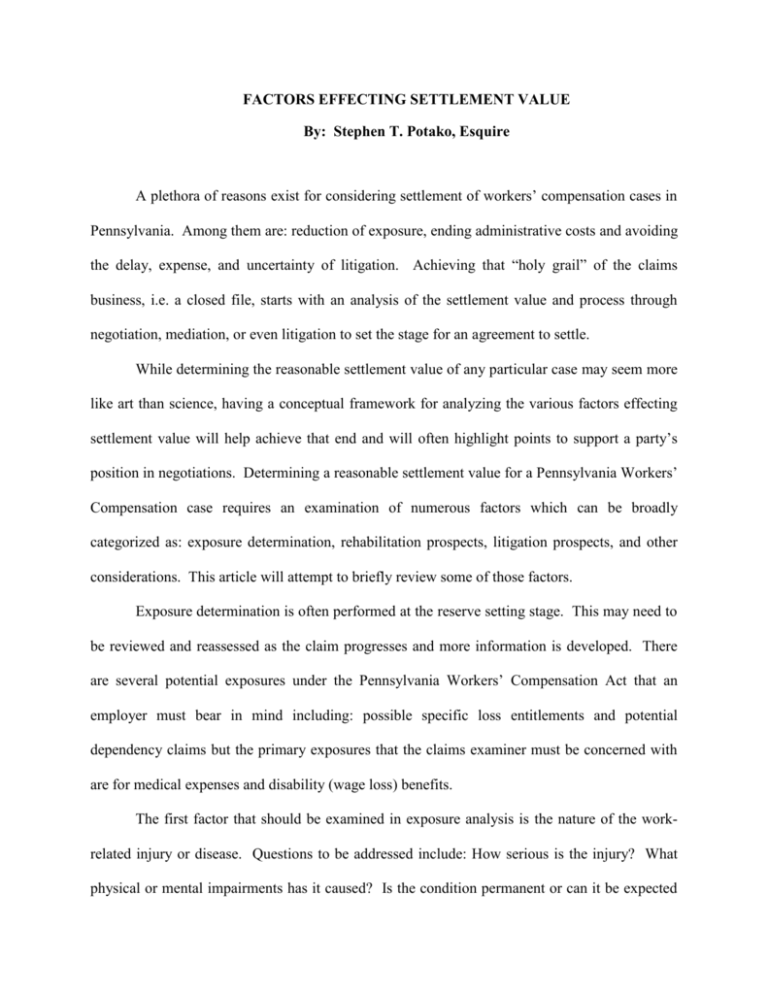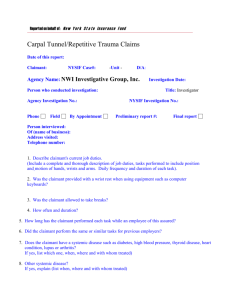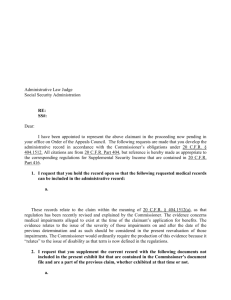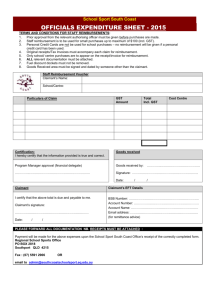View as DOC - Post & Schell, PC
advertisement

FACTORS EFFECTING SETTLEMENT VALUE By: Stephen T. Potako, Esquire A plethora of reasons exist for considering settlement of workers’ compensation cases in Pennsylvania. Among them are: reduction of exposure, ending administrative costs and avoiding the delay, expense, and uncertainty of litigation. Achieving that “holy grail” of the claims business, i.e. a closed file, starts with an analysis of the settlement value and process through negotiation, mediation, or even litigation to set the stage for an agreement to settle. While determining the reasonable settlement value of any particular case may seem more like art than science, having a conceptual framework for analyzing the various factors effecting settlement value will help achieve that end and will often highlight points to support a party’s position in negotiations. Determining a reasonable settlement value for a Pennsylvania Workers’ Compensation case requires an examination of numerous factors which can be broadly categorized as: exposure determination, rehabilitation prospects, litigation prospects, and other considerations. This article will attempt to briefly review some of those factors. Exposure determination is often performed at the reserve setting stage. This may need to be reviewed and reassessed as the claim progresses and more information is developed. There are several potential exposures under the Pennsylvania Workers’ Compensation Act that an employer must bear in mind including: possible specific loss entitlements and potential dependency claims but the primary exposures that the claims examiner must be concerned with are for medical expenses and disability (wage loss) benefits. The first factor that should be examined in exposure analysis is the nature of the workrelated injury or disease. Questions to be addressed include: How serious is the injury? What physical or mental impairments has it caused? Is the condition permanent or can it be expected to improve? Can full recovery be expected or will there be a residual impairment? What type of treatment is necessary? What expense will be required for the treatment? What is the likely outcome of the treatment and what complications may arise? Answers to these questions will help determine the exposure for direct medical expenses and will also impact the projected exposure for disability benefits. In analyzing the disability exposure, other factors that must be considered include: claimant’s compensation rate, age, life expectancy, and administrative status. If claimant’s entitlement is to partial rather than total disability benefits, the statutory maximum may apply to limit the extent of those benefits to 500 weeks. The claims examiner must also keep the date of injury in mind as it will determine which set of rules apply, (Pre-Act 44, Act 44, or Act 57). This will effect not only what credits and offsets are potentially available (unemployment compensation, severance, pension or Social Security retirement) but also the availability of earning power determinations through expert testimony (Labor Market Surveys), the availability of impairment rating evaluations, the method of calculation for the Average Weekly Wage, and also the possible availability of other cost control tools, such as the utilization review procedures and suspension by Notice and Affidavit of Return to Work, and the use of Employee Verification Forms for the self-reporting of benefits, wages, and change in condition. After an analysis of the potential exposure is done, the examiner should next assess the rehabilitation prospects to see whether that exposure can be reduced. Again, the availability of medical treatment that may improve claimant’s condition or cause a full recovery should be pursued as this will effect all aspects of the rehabilitation process. If medical disability exists, then a determination must be made as to what economic disability results, if any. In other words, the medical functional impairment (medical disability) must be viewed in the context of claimant’s pre-injury position or potential alternative positions to see if those impairments actually prevent claimant from performing some vital aspect of the work (economic disability). If so, one must determine whether the employer willing to modify the claimant’s work to accommodate the medical restriction or offer existing alternative work. If no suitable work exists with the original employer, then several questions must be addressed. What prospects exist for locating suitable alternative employment with other employers? Is funded employment a viable option? Is suitable alternative work generally available in the applicable labor market? How would such alternative wage rates compare with claimant’s pre-injury Average Weekly Wage? What prospects exist for claimant’s alternative wage rates to increase causing a corresponding reduction in wage loss and partial disability compensation? In considering rehabilitation prospects, particularly in a situation involving permanent residual impairments, there are several barriers to alternative employment that must be considered including: lack of transferable skills, advanced age, other medical conditions effecting potential employability, claimant’s attitude about alternative work, lack of transportation, language problems, potential loss of Union benefits, and any adverse effect of a return to work or other claims (third party case, Social Security disability claim, or private disability entitlement). In particularly difficult cases or where rehabilitation efforts have been actively opposed by claimant, the claims examiner should also consider litigation prospects in determining settlement value. Often a claimant will be content with the status quo and will not consider settlement until there is some threat to his ongoing entitlement, usually in the form of a Petition to Terminate, Modify, or Suspend Benefits. In deciding whether to initiate litigation with the employer as the moving party, the claims examiner must first determine whether there is a legal basis to proceed (e.g. full recovery medical opinion, job offer of medically suitable work, claimant’s bad faith response to appropriate job referrals, appropriate Labor Market Survey with Earning Power Assessment, etc.). If there is no legal basis to proceed, the employer risks the determination of an unreasonable contest, with assessment of claimant’s attorney’s fees against the employer. If there is a legal basis to proceed with employer initiated litigation, then the potential and likely outcomes should be considered. That requires an assessment of: the strength of each parties evidence (competence, credibility, and persuasiveness), the experience and skill of trial counsel, and the orientation of the Workers’ Compensation Judge. The extent of potential relief available through litigation should be noted (e.g. termination, suspension, modification). The potential for retroactive relief and Supersedeas Fund reimbursement should also be determined. Another consideration in deciding whether to settle or litigate to conclusion is whether the case involves any unique legal issues of precedential value, which, if decided adversely, have the possibility of creating undesirable case law. The prospects for relief through litigation must then be weighed against the costs of such litigation including: legal fees, expert witness fees, general litigation costs (transcription charges, record fees, etc.) claimant’s litigation costs, the potential for unreasonable contest attorneys fees, the potential for an award of penalties, and the additional costs of litigating appeals at the Appeal Board and Commonwealth Court level. One must also bear in mind the considerable cost of having to pay ongoing disability benefits during the course of often protracted litigation in the event the employers initial supersedeas request is denied. When the litigation involves claimant as the moving party seeking to establish an entitlement (Claim, Reinstatement, Review, Set Aside Final Receipt Petitions) some additional factors should be considered when assessing settlement value. They include: claimant’s ability to finance his case and litigation costs, claimant’s ability to wait for a decision, the willingness of claimant to “limit his claim” in order to present medical evidence by report and avoid expert witness fees, and the potential that claimant may return to work during the pendency of the Petition. After litigation prospects are assessed, there remain other considerations that may have a bearing upon settlement value. As most settlements will deprive the employer of the potential right to seek Supersedeas Fund reimbursement, that loss should be viewed as an opportunity cost in assessing settlement considerations. The existence of a third party case arising from the work injury may give rise to a subrogation claim which creates the potential for a recovery to the employer. This subrogation claim value can be negotiated and waived in whole or in part as an inducement to settle remaining workers compensation exposures. The availability of other benefits for claimant (e.g. Social Security disability, private disability, medical insurance, etc.) may create additional opportunities for settlement of the ongoing workers’ compensation claims. However, please note that the existence of any Medicare claims for reimbursement (Medicare’s super lien) and Medicare’s interest in preventing unwarranted “cost shifting” to its programs may require special treatment. Finally, there may be certain policy issues that effect an employer’s decision as to whether it will even consider settling certain claims such as: those involving potential fraud and those with the potential to effect many co-workers and “open the floodgates” etc. Consideration of these various factors effecting settlement value and early development of information necessary to address them will substantially aid the claims examiner in determining a reasonable settlement value, in justifying that settlement position, and in negotiating with the opposing party.






